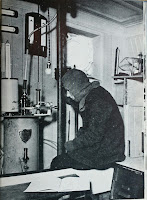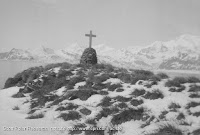 For the last installment of the “Exhibit that wasn’t”, we introduce the last batch of items that the students from Ross Virginia’s Spring 2016 “Pole to Pole” class selected but could not be displayed in the physical exhibit cases. These items fell into three themes that the students thought were significant for Shackleton’s expedition.
For the last installment of the “Exhibit that wasn’t”, we introduce the last batch of items that the students from Ross Virginia’s Spring 2016 “Pole to Pole” class selected but could not be displayed in the physical exhibit cases. These items fell into three themes that the students thought were significant for Shackleton’s expedition.
The first theme is scientific documentation. Though preoccupied with worries of being stranded in an uninhabited island, the Endurance crew did not let those fears hamper them from carrying out the original purpose of the journey - obtaining more knowledge of the Antarctica.
This photo of the laboratory aboard the Endurance from Shackleton’s Argonauts by Frank Hurley shows the crew members making scientific observations. The crew proceeded research and experiments in meteorology, oceanography and physics with full speed while stranded, and the observations made during this time were highly valuable. For instance, the crew’s observations contributed to a better understanding of different characteristics of sea-ice forms.

Another important item on the agenda for the crew was to document the scenery of Antarctica as thoroughly as possible. This photo of Frank Hurley, the official photographer of the Endurance expedition, portrays his willingness to risk bodily harm to capture the perfect image.
The crew’s tenacity to document the Antarctic is especially noteworthy in the context that nothing guaranteed their survival or rescue. However, the crew members never lost hope, and this hope was what motivated them to continuously pursue research goals and create records for future study. Their perseverance has enriched our understanding of the arctic region and scientific knowledge in various fields.
 Another theme that students emphasized through their selection of exhibit items was struggle for survival.
Another theme that students emphasized through their selection of exhibit items was struggle for survival.
The photo to the left, found in Shackleton’s Argonauts by Frank Hurley, documents the crew's rescue at the end of the Endurance expedition in 1916. Upon Shackleton’s return, the crew members were whooping and hollering as they rejoiced over their rescue after a strenuous time on Elephant Island. The rescue came after almost two years of a struggle for survival. What struck students as impressive was that not a single life was lost. This demonstrates the crew members' mental and physical robustness which is exceptional in that they manage to maintain such tenacity in the midst of mental and physical challenges in a barren land.
 The last theme is the legacy of Shackleton's Endurance expedition.
The last theme is the legacy of Shackleton's Endurance expedition.
This picture of the Shackleton Cross on South Georgia Island in Endurance: An Epic Polar Adventure and the subsequent passage describe the construction of the cross on South Georgia Island in memory of Ernest Shackleton after his death in 1922. Though it has been a hundred years since the Expedition's return, the courageous story of Shackleton's Endurance expedition lives on through the archival materials and memorabilia like the Cross on South Georgia Island. The account of the expedition continues to be passed down to following generations in more accessible forms such as movies, novels, and children books.
Material selection and exhibit conceptualization by Kelsey Catano '18, Taryn Deck '17, Kiana Outen '18, Max Saylor '19, Miranda Gish '18, Anna Ellis '19, Nora Masler '18, Margaret Currie '17, Kevin Gross '19, and Noah Van Dyke '18.
After the exhibit comes down, you can see Shackleton's Argonauts by asking for Stef G850 1914 .H87; Endurance: An Epic Polar Adventure is Stef G850 1914 .W6.
To learn more about the physical exhibit, visit the exhibits page.
No comments:
Post a Comment